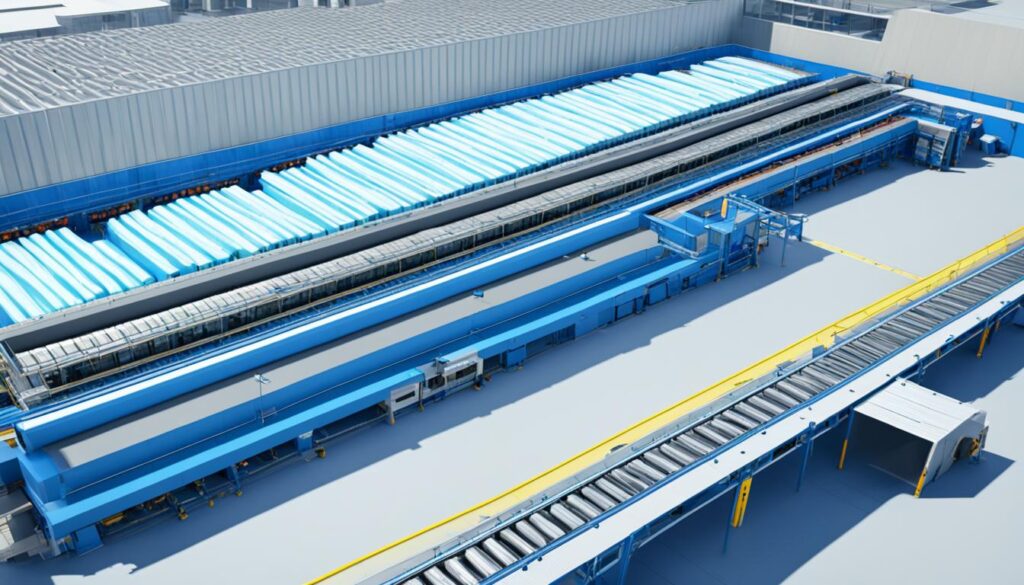In today’s retail landscape, efficient order fulfillment is critical to ensure customer satisfaction and success in the market. The optimization of the order fulfillment process is the key to a seamless and satisfactory customer experience. Any organization that prioritizes the optimization of the order fulfillment process can drive their business towards long-term prosperity.
In this article, we will discuss various techniques and methods to streamline the order fulfillment process and improve customer engagement and satisfaction.
Key Takeaways:
- Efficient order fulfillment ensures customer satisfaction.
- Prioritizing order fulfillment optimization can help businesses succeed in the market.
- Streamlining the fulfillment process is essential for seamless operations.
- Order management systems, inventory control, and demand forecasting play a crucial role in order fulfillment optimization.
- Optimization of the supply chain can enhance fulfillment operations.
Understanding the Order Fulfillment Process
The order fulfillment process involves multiple stages that begin with receiving an order and end with product delivery to the customer. Understanding this process is crucial for businesses to optimize their operations and improve overall efficiency. The key stages in order fulfillment process are:
- Order Processing: This stage involves verifying the order details, checking product availability, and preparing the order for shipment. It also includes identifying any special customer requirements, such as gift wrapping or personalized messages.
- Inventory Management: This stage focuses on managing inventory levels, ensuring sufficient stock for fulfilling orders, and preventing overselling. Inventory accuracy is important for maximizing efficiency and delivering products on time.
- Order Assembly: This stage involves picking products from the inventory and preparing them for shipment. It also involves packaging the products securely to prevent damage during transit.
- Shipping: This stage includes creating shipping labels, scheduling pickups, and sending products to the customer through various modes of transportation, such as ground or air transport.
- Delivery: This stage concludes the order fulfillment process by delivering the product to the customer. It requires coordination with the shipping carrier and tracking the shipment until it reaches its destination.
The order fulfillment process can be challenging due to the complexity of managing inventory, tracking orders, and ensuring customer satisfaction. However, by streamlining this process, businesses can enhance customer loyalty and loyalty and improve their bottom line.
Leveraging Order Management Systems
Implementing an effective order management system can transform the way your business handles order processing and fulfillment tasks. Such systems allow for streamlined operations, increased precision, and efficiency in managing customer orders, from the time they are received until they are delivered.
By using an order management system, businesses can easily track and manage order details, payment, and shipment information. This system helps optimize the warehouse workflow and improve inventory accuracy, leading to better order fulfillment and ultimately, increased customer satisfaction.
With customizable order management systems, businesses can tailor their processes to fit their unique needs. Moreover, these systems can integrate with other tools such as invoicing and accounting software, making the management of orders and finances more efficient.
Utilizing an order management system can also improve communication with customers and suppliers, by providing real-time updates on order status and delivery times. This creates a sense of transparency and trust, leading to increased brand loyalty and repeat business.
Order management systems come with varying levels of complexity and functionality. Depending on the size and needs of the business, a company may require a simple system or a more sophisticated one. In any case, implementing an effective order management system is one of the key steps forward in optimizing your order fulfillment process.
Optimizing Warehouse Management
Effective warehouse management is crucial to streamlining order fulfillment operations. Adopting an efficient warehouse management system can significantly enhance inventory control, reduce errors, and optimize the movement of products within the warehouse. Inventory management plays a key role in the success of warehouse optimization.
The implementation of a warehouse management system can revolutionize inventory management and streamline daily processes. The system can identify inventory levels, reduce manual labor, and improve accuracy in maintaining inventory records over manual methods.
“An effective warehouse management system streamlines inventory management, reduces errors, and optimizes the movement of products within the warehouse.”
Inventory Management Techniques
Inventory management techniques such as cycle counting, demand forecasting, and ABC analysis can help businesses address inventory challenges and optimize warehouse operations. The cycle counting method involves counting a specific amount of inventory each day to identify discrepancies and maintain accurate inventory records. Accurate demand forecasting can lead to better inventory management, reducing stock-outs and improving customer satisfaction. Businesses can also adopt ABC analysis to prioritize inventory based on its significance, helping to optimize storage location and movement within the warehouse.
The Role of Automated Systems in Warehouse Management
With the help of automated systems, businesses can streamline warehouse operations and reduce the likelihood of human errors. Automated storage and retrieval systems (ASRS) can ensure that products are stored in their optimal locations and are easily accessible. Additionally, automated packing, labeling, and shipping systems can accurately process orders, reducing the risk of errors and delays. These systems can also improve the movement of products within the warehouse and minimize operational costs.
Supply Chain Optimization for Seamless Operations
Supply chain optimization plays a vital role in enhancing order fulfillment efficiency. By optimizing transportation and improving collaborations with suppliers, businesses can overcome logistical challenges and ensure seamless operations throughout the supply chain.
One effective strategy for supply chain optimization is to implement a real-time tracking system, allowing businesses to track shipments from the moment they leave the warehouse until they reach the customer’s doorstep. This provides greater visibility into product movement and enables better decision-making around inventory management and transportation.
Another key aspect of supply chain optimization is the use of data analytics to identify patterns and trends, enabling businesses to make more informed decisions around inventory control, demand forecasting, and transportation planning. By leveraging these insights, businesses can improve efficiency, reduce costs, and enhance customer satisfaction.
Furthermore, optimizing collaboration with suppliers can lead to greater transparency and communication, facilitating more effective inventory management and improving lead times. This can result in reduced stockouts and faster delivery times, further enhancing the overall customer experience.
By prioritizing supply chain optimization, businesses can achieve smooth operations and improve order fulfillment efficiency, ultimately driving long-term success.

Efficient Order Processing Techniques
Efficient order processing plays a critical role in streamlining order fulfillment. By minimizing processing time and errors, businesses can improve customer satisfaction and reduce operating costs. The following are some techniques and best practices for optimizing order processing:
1. Automation
Automating routine tasks such as data entry, order status updates, and invoice generation can significantly reduce processing times, minimize errors, and improve accuracy. Consider implementing solutions such as robotic process automation, machine learning, or natural language processing for more efficient order processing.
2. Workflow Optimization
Reviewing your current order processing workflow and identifying areas for improvement can help you streamline your operations. Use clear and concise labels and instructions to minimize confusion and speed up processing times. Consider using visual cues such as color coding to indicate order status.
3. Order Prioritization
Not all orders are equal. By prioritizing orders based on factors such as customer loyalty, order value, or shipping distance, businesses can allocate resources more effectively, reduce turnaround times, and improve overall customer satisfaction.
Utilizing these techniques and best practices can help businesses improve their order processing efficiency, resulting in better customer satisfaction rates and more profitable operations.
Shipping and Receiving Optimization
Effective shipping and receiving processes are crucial to minimizing delays, maximizing accuracy, and reducing costs. To achieve shipping and receiving optimization, businesses should implement the following strategies:
Use Technology to Streamline Processes
Technology can significantly improve shipping and receiving operations. Inventory management systems, barcode scanning, and electronic data interchange (EDI) enable faster and more accurate tracking of products and reduce the risk of errors. For example, using a barcode scanning system can reduce the time required to receive inventory, help ensure accuracy, and minimize manual data entry errors.
Ensure Effective Communication
Effective communication between all parties involved in shipping and receiving is essential to avoid errors and delays. This includes clear communication between suppliers, carriers, customers, and internal departments. Using a centralized communication platform, such as a shared database, can improve coordination and enable all parties to stay up-to-date on order status.
Streamline Documentation Processes
Streamlining documentation processes minimizes the risk of errors and delays. Creating standardized packing lists, shipping labels, and invoices can help to ensure consistency and reduce the time required for data entry.
Implementing these strategies can improve the efficiency and accuracy of shipping and receiving processes, reducing costs and improving customer satisfaction.
Inventory Accuracy for Enhanced Fulfillment
Accurate inventory records play a crucial role in ensuring successful order fulfillment. Even minor discrepancies can result in delays, product shortages, or order cancelations, which can negatively impact customer satisfaction and business credibility.
Improving inventory accuracy requires a dedicated effort on the part of the business, involving regular audits, cycle counting, and implementing automation and technology-based solutions. By conducting frequent checks, inventory records can be updated in real-time, providing a reliable and accurate view of stock level and demand.
According to a recent study, businesses with high inventory accuracy are significantly more likely to achieve customer satisfaction rates above 95%, highlighting the direct impact of inventory accuracy on customer experience and business success.
“Inventory accuracy is the cornerstone of efficient order fulfillment. By ensuring that inventory records match actual stock levels, businesses can avoid costly mistakes and enhance customer satisfaction, which leads to improved customer loyalty and profitability”
The Power of Demand Forecasting
Accurate demand forecasting is a crucial aspect of order fulfillment optimization. By anticipating customer demand and trends, businesses can optimize their inventory management, reduce stock-outs, and improve customer satisfaction.
Incorporating demand forecasting into daily operations can significantly enhance the efficiency of order fulfillment processes. It helps businesses to identify the right balance of stock levels, reducing the risk of overstocking, which in turn reduces the need for frequent ordering and associated costs.
Demand forecasting enables businesses to be better prepared for seasonal fluctuations and unforeseen events. By understanding patterns in customer behavior, businesses can allocate resources more effectively, plan for adequate inventory levels and mitigate the impact of unforeseen demand spikes.
Moreover, demand forecasting can have a positive impact on customer satisfaction. By having the right product in stock at the right time, businesses can fulfill orders more quickly, minimize backorders and delays, and improve overall customer experience. This builds a loyal customer base, contributing to long-term business growth.
Example:
| Month | Number of Orders | Actual Sales | Forecasted Sales |
|---|---|---|---|
| January | 45 | $5,300 | $5,400 |
| February | 50 | $5,800 | $6,100 |
| March | 65 | $7,150 | $7,000 |
As shown in the example above, demand forecasting can help businesses predict sales levels and allocate resources accurately.
Order Fulfillment Optimization Wrap Up
Order fulfillment optimization is a critical component of any successful business. By streamlining the order fulfillment process, businesses can achieve increased efficiency, reduce errors, and improve customer satisfaction.
Understanding the order fulfillment process is the first step in optimizing it. Implementing an order management system, optimizing warehouse management, and improving supply chain management all play important roles in achieving efficiency. Efficient order processing, accurate inventory records, and demand forecasting are also vital components in achieving successful order fulfillment.
Overall, order fulfillment optimization requires a comprehensive approach that involves implementing the right systems and techniques, improving communication, and prioritizing customer satisfaction. By doing so, businesses can achieve long-term success and meet the ever-changing demands of their customers.
Learn More About Amazon FBA
FAQ
What is order fulfillment optimization?
Order fulfillment optimization refers to the process of improving and streamlining the various stages of fulfilling customer orders, from receiving the order to delivering the product. It involves implementing strategies and utilizing tools to enhance efficiency, accuracy, and customer satisfaction.
Why is order fulfillment optimization important?
Order fulfillment optimization is important because it allows businesses to operate more efficiently and meet customer expectations. By optimizing the order fulfillment process, businesses can reduce errors, improve inventory management, enhance communication, minimize delays, and ultimately provide a better customer experience.
How can an order management system improve order fulfillment?
An order management system is a software solution that helps businesses manage and track orders from receipt to delivery. It optimizes the order fulfillment process by automating tasks, improving inventory accuracy, providing real-time visibility, and streamlining communication between departments. This leads to faster order processing, reduced errors, and improved customer satisfaction.
What is the role of a warehouse management system in order fulfillment optimization?
A warehouse management system (WMS) plays a vital role in order fulfillment optimization by improving inventory accuracy, reducing picking errors, and optimizing the movement of products within the warehouse. It provides real-time visibility into inventory levels, streamlines warehouse operations, and enables efficient order picking and packing, resulting in faster fulfillment and reduced costs.
How does supply chain optimization contribute to seamless order fulfillment?
Supply chain optimization focuses on enhancing collaboration between suppliers, optimizing transportation, and overcoming logistical challenges. By streamlining the entire supply chain process, businesses can reduce lead times, optimize inventory levels, ensure faster order fulfillment, and reduce costs associated with transportation and warehousing.
What techniques can be used to optimize order processing?
Techniques for optimizing order processing include automating repetitive tasks, implementing workflow optimization strategies, and prioritizing orders based on various factors such as urgency and customer loyalty. By streamlining order processing, businesses can reduce manual errors, expedite fulfillment, and meet customer demands more efficiently.
How can shipping and receiving optimization improve order fulfillment?
Shipping and receiving optimization involves implementing efficient processes, utilizing technology such as barcode scanning and automated sorting systems, and improving communication between different stakeholders. By optimizing shipping and receiving, businesses can minimize delays, reduce errors, and enhance overall efficiency, resulting in faster and more accurate order fulfillment.
Why is inventory accuracy important in order fulfillment?
Inventory accuracy is crucial in order fulfillment as it ensures that businesses have the right products available to meet customer demands. Accurate inventory records enable businesses to avoid stockouts, optimize replenishment processes, reduce order cancellations, and improve customer satisfaction by fulfilling orders in a timely and accurate manner.
How does demand forecasting contribute to order fulfillment optimization?
Demand forecasting involves predicting future customer demand based on historical data, market trends, and other relevant factors. Accurate demand forecasting helps businesses make informed decisions about inventory management, production planning, and order fulfillment. By understanding and anticipating customer demand, businesses can optimize inventory levels, reduce stockouts, and meet customer expectations more effectively.




